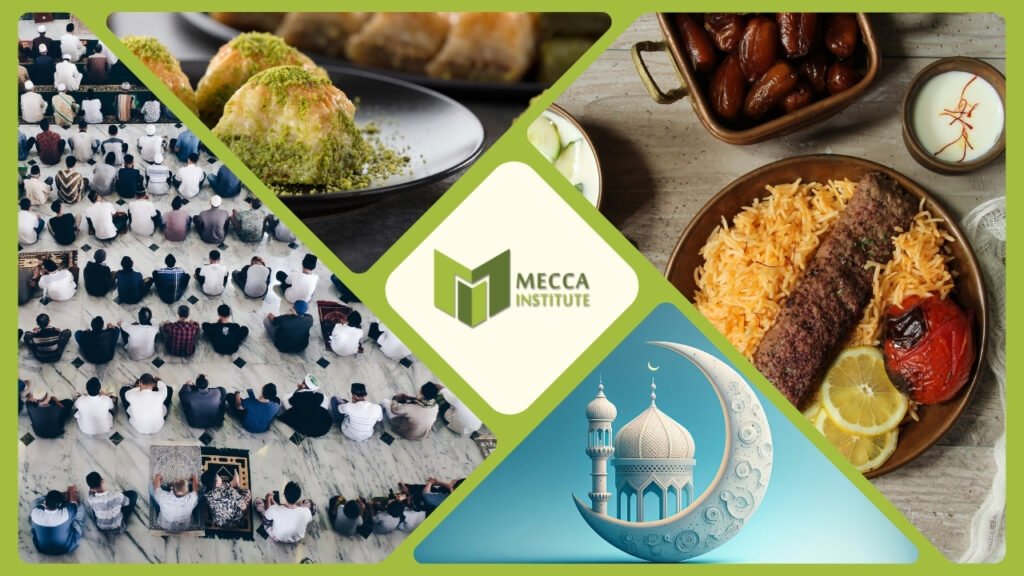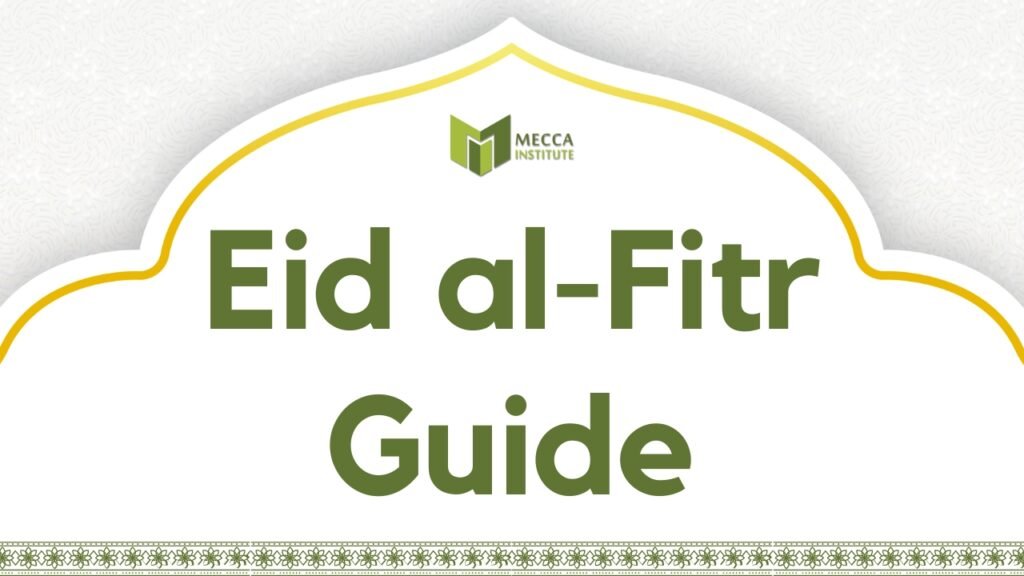Eid al-Fitr is a major festival, says Imam Daayiee Abdullah, noting a diversity of traditions across the Muslim World.
Muslims around the world celebrate the end of the fasting month of Ramadan with festivities.
Eid al-Fitr traditions include food, music, parties, and more, but it is also a time to pray and congregate as a community.
In this guide, I will share some of the many blessings Muslims experience celebrating this major festival.
Eid al-Fitr
“Eid al-Fitr” (“عيد الفطر”) translates to “Festival of Breaking the Fast” in Arabic. It is the biggest festival on the Muslim calendar.
The festival marks the end of Ramadan, a month of fasting and spiritual reflection for Muslims worldwide.
On this joyous occasion, families come together to pray, share meals, and exchange gifts.
In many parts of the Muslim World, mosques are adorned, and communities engage in charitable acts.
Zakat al-Fitr, the specific charity for this festival, is to ensure that everyone can partake in the celebrations.
It’s a time of gratitude, unity, and renewal of faith with lively festivities and expressions of love and kindness.
Eid Greetings
Muslims greet each other for Eid in different ways. The most popular greeting is “Eid Mubarak” (عيد مبارك).
“Blessed festival” is the meaning of that phrase. In cultures where Arabic is not the first language, it means specifically Eid.
That said, you should know “Eid” just means “festival.” So, Lebanese Christians, for example, use “Eid” when they celebrate Christmas!
Another popular phrase in Arabic is “Eid Sa’id” (عيد سعيد), which means “Happy Eid,” expressing joy and goodwill.
In most Muslim countries where Arabic is not the first language, there are also other phrases. For example, in Indonesia, “Selamat Lebaran” is a popular greeting.
Eid al-Fitr Traditions

Eid traditions are diverse across Muslim countries. Muslims like myself who travel gain a lot of culture from this.
In Pakistan, families gather to perform the Eid prayer at mosques and then distribute “Eidi,” monetary gifts given to children.
In Indonesia, a unique tradition inherited from China involves visiting the graves. Typically, people visit the graves of the family members, clean them, and offer prayers.
Speaking of Indonesia, they also have the custom of “Tunjangan Hari Raya” or THR. It is a governmental mandate where employers must give an amount equal to one month’s salary to employee as a gift during Eid.
In Turkey, it’s common to prepare and distribute “Bayram bread” to neighbors and loved ones as a gesture of goodwill. Bayram means “festival” in Turkish.
In Egypt, families often celebrate with “Oum Ali,” a special dessert in which puff pastry, milk, nuts, and raisins create a creamy, nutty dessert.
Of course, I cannot recount all the way traditions.
Eidi in the Muslim World
Eidi, or “Eid Rights” or “Haq ul Eid” (حق العيد), is the tradition of giving money or gifts to children during Eid.
This is a significant cultural tradition in many Muslim countries. Money or gifts are given as a gesture of love, generosity, and blessing during the festival.
In Indonesia, Eidi is called “Uang Lebaran” or “Eid Money” (“Lebaran” is the word for Eid).
Eidi is a way to spread joy and happiness, especially among younger family members. Therefore, it reinforces the spirit of sharing and community that defines the festival.
Food for Eid
Eid foods are also very diverse and are celebrated during Eid across cultures.
Sweets like baklava and maamoul, savory items like biryani and samosas, and so much more are part of the Eid feast extravaganza.
“Bayram baklavası” is a special baklava for Eid in Turkey. Muslim Turks use phyllo dough, nuts, and sugar syrup to make this addictive dessert.
The people of Sham, including Lebanon and Syria, use semolina or flour, dates, nuts, and sugar to create maamoul. Maamoul has a delicate sweetness with a strong, nutty flavor.
Indonesian Muslims prepare “ketupat,” a traditional rice cake that is wrapped in palm leaves. The origins of ketupat date back to the Javanese Sultanate of Demak in the 15th Century.
Persian Muslims prepare major feast. Khoresh-e Fesenjan is a popular dish during Eid. This is a stew where pomegranate syrup and crushed walnuts create delicious meal.
In China, there are many traditions. Xi’an Muslims, for instance, prepare a famous beef pie. “Niurou Xi’an bing” (牛肉馅饼), which is a pastry that has beef fillings.
There are so many Eid foods to mention.
Eid Music
Music is another major aspect of Eid celebrations in many Muslim cultures.
“Ya Leilet El Eid” by Umm Kulthum is a popular Eid song in most Middle Eastern countries. The song is from over 80 years ago, but it’s still popular.
In nearby Sudan, Hamad al-Rih’s “Ahla Minnik” is a popular Eid song. This was from the 1970s and is still very popular.
“Eidan Aiyan” by Arif Lohar is a newer hit in Pakistan. This is a Punjabi folk song that Muslims in India and Pakistan enjoy these days.
Speaking of new songs, “Watandar e Gulem Eidet Mubarak” by Farhad Darya was a major hit. This Aghani song was trending on TikTok, although it is a rendition of an old song.
Meanwhile, Marina Toshich’s “Bajram Dođe Mirišu Avlije” is a classic Bosnian Eid song.
Therefore, Eid songs are everywhere.
Eid Parties

Eid parties around the world are lively celebrations. Joy, food, and festivities are plentiful.
Families and friends come together to share meals, exchange gifts, and engage in prayers and rituals.
In some regions, streets are adorned with lights and decorations. This creates a festive atmosphere.
Music and dancing are common. Traditional tunes and rhythms always add to the merriment. Children often enjoy activities like face painting, games, and storytelling.
Finally, many Muslim young adults head to clubs for Eid fun, where they will dance to remixes of traditional Eid songs. They enjoy the night away with friends and strangers.
Major Muslim cities such as Cairo, Delhi, and Istanbul see big parties. In many neighborhoods, it is like a wedding.
Eid parties show the diversity of cultures and traditions, but they unite communities in celebration and gratitude.
Conclusion
Eid al-Fitr is a great festival for Muslims to experience. This is a major event to celebrate the end of Ramadan.
As previously shared, there are many traditions in diverse Muslim societies. Food, music, and parties are some of the ways people celebrate.
I would love to hear about your cultural ways of celebrating Eid. Share it with us.
Eid Mubarak, and may Allah continue to guide us all.
Imam Daayiee Abdullah is the Executive Director of MECCA Institute and the author of “Progressive Islam,” a historic book that defines Progressive Islam.


Pingback: Islamic Calendar Guide for Muslim Rituals, Festivals, and More